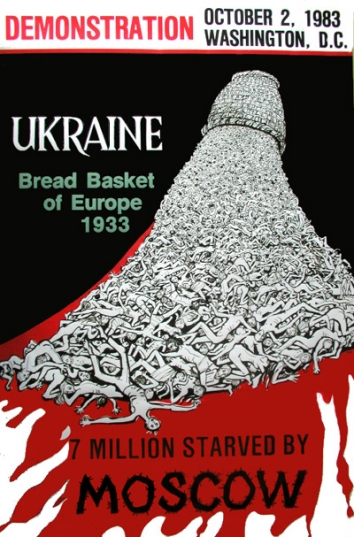Featured Galleries USUBC COLLECTION OF OVER 160 UKRAINE HISTORIC NEWS PHOTOGRAPHS 1918-1997
 Holodomor Posters
Holodomor Posters

Resource nationalism remains number one risk for miners
 Ernst & Young LLC, Kyiv, Ukraine
Ernst & Young LLC, Kyiv, Ukraine
12 July, 2012
SYDNEY, 11 JULY 2012 – Resource nationalism remains the number one risk for mining and metals companies around the world, as ranked by Ernst & Young’s annual Business risks facing mining and metals 2012-2013 report.
The global skills shortage and infrastructure access retained second and third spots respectively in the risk rankings this year, as more and more countries experience these constraints. Rapidly escalating costs have pushed cost inflation up from number eight to four.
Ernst & Young Global Mining & Metals Leader Mike Elliott says resource nationalism is now a bigger challenge than it was 12 months ago, at a time when the myriad of risks facing the sector have become increasingly complex and critical.
“Resource nationalism retains the number one risk ranking with many governments around the world going beyond taxation in seeking a greater take from the sector, with a wave of requirements introduced around mandated beneficiation such as bans on the export of unprocessed raw materials, as well as export levies and limits on foreign ownership,” says Elliott.
“There is no doubt projects around the world have been deferred and delayed, and in some cases investment withdrawn altogether because of the degraded risk/reward equation.”
“The uncertainty and destruction of value caused by sudden changes in policy by the governments of resource-rich nations cannot be understated.”
“Miners must continue to engage with governments to foster a greater understanding of the value a project brings to the host government, country and community, and be better able to negotiate appropriate trade-offs that preserve the value to miners, governments and other stakeholders.”
“Infrastructure access is ranked higher as a risk factor in the CIS countries as this risk continues to dominate the investment agenda for many of the local and Global mining companies, especially in the remote locations of Far East of Russia” – says Evgeny Khrustalev, CIS Industrial Products Leader.
Sharing the benefits makes its debut at number nine this year, with social licence to operate, capital project execution, price and currency volatility, capital allocation, and fraud and corruption rounding out the top 10.
Risks now more complex, more critical
“Almost all of the top 10 risks are more complex and more critical for miners now than they were 12 months ago – the imperative for miners to manage these risks and understand the changing risk/reward equations has arguably never been higher,” says Elliott.
“In a rising market, the returns justified taking on more risk. While the demand outlook remains strong for the long term, the price peaks have passed and so miners are no longer able to rely on increasing prices to balance increased risk.”
Sharing the benefits
The relative prosperity of the mining and metals sector at a time when many other sectors in the global economy are struggling has seen a new risk for miners – sharing the benefits.
“Stakeholders ranging from governments, to workers, investor, local communities and suppliers feel they are entitled to a greater proportion of the value created by mining and metals companies,” says Elliott.
“Mining and metals companies are forced to balance the expectations and needs of their many stakeholders. When they fail to meet expectations or fully understand needs, it can result in strikes, supply disruptions, shareholder activism, community unrest and governments using their power through resource nationalism.”
“Miners are willing to yield some returns on the appropriate transfer of risk to stakeholders, however many of the stakeholders who want an increased share of the mining and metals profits are not taking on additional risk for this increased return.”
“Balancing competing demands and getting this risk transfer is the challenge for the sector.”
Skills shortage
Elliott says the acute skills shortage seen in Australia and Canada has spread to more places during the past year, with projects in countries such as Indonesia, Mongolia, Brazil, Chile, Peru and Mozambique all plagued by this challenge.
“Strong commodity prices and confidence in the long-term sector fundamentals have created a record level of new developments and mine expansions,” he says.
“This level of investment is driving demand for skilled workers around the world and drawing on the same global pool of talent to build and operate these projects.”
The 2012 top strategic business risks in the global mining and metals sector are:
- Resource nationalism (1 in 2011)
- Skills shortage (2)
- Infrastructure access (6)
- Cost inflation (8)
- Capital project execution (5)
- Social licence to operate (4)
- Price and currency volatility (6)
- Capital management and access (7)
- Sharing the benefits (new)
- Fraud and corruption (10)
About Ernst & Young
Ernst & Young is a global leader in assurance, tax, transaction and advisory services. Worldwide, our 152,000 people are united by our shared values and an unwavering commitment to quality. We make a difference by helping our people, our clients and our wider communities achieve their potential.
Ernst & Young expands its services and resources in accordance with clients’ needs throughout the CIS. 4000 professionals work at 18 offices in Moscow, St. Petersburg, Novosibirsk, Ekaterinburg, Kazan, Krasnodar, Togliatti, Yuzhno-Sakhalinsk, Almaty, Astana, Atyrau, Baku, Kyiv, Donetsk, Tashkent, Tbilisi, Yerevan, and Minsk.
Ernst & Young established its practice in Ukraine in 1991. Ernst & Young Ukraine now employs more than 500 professionals providing a full range of services to a number of multinational corporations and Ukrainian enterprises.
For more information about our organization, please visit www.ey.com/ua.
This news release has been issued by EYGM Limited, a member of the global Ernst & Young organization that also does not provide any services to clients.











